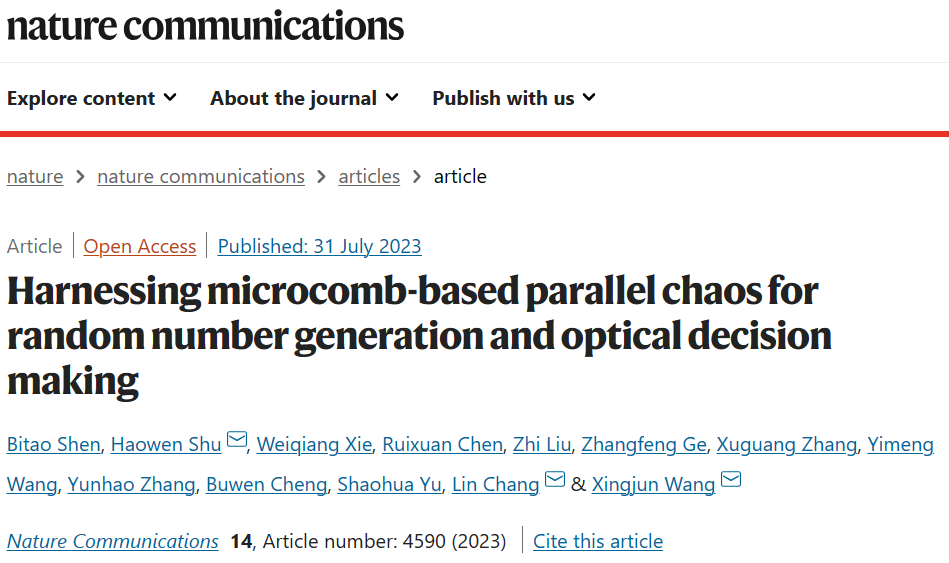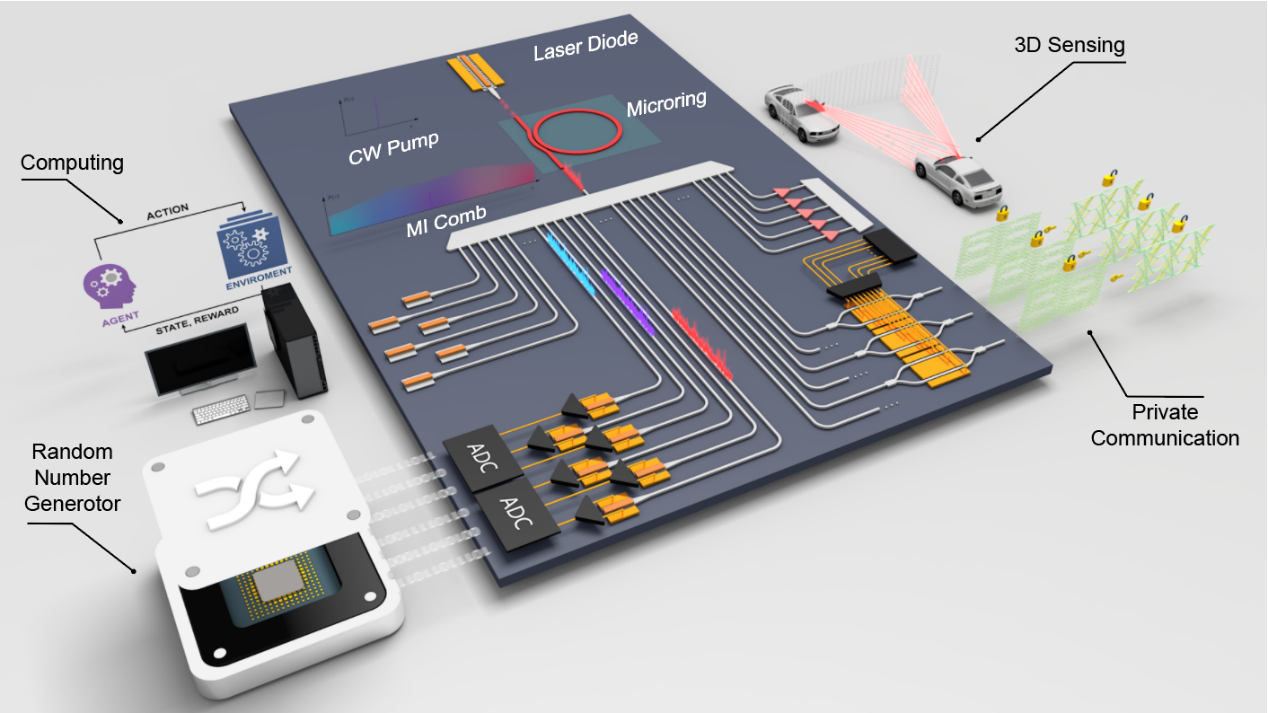On July 31, 2023, the Center published the article "Harnessing microcomb-based parallel chaos for random number generation and optical decision making". The article validates a massively parallel chaotic signal generation scheme based on chaotic microcomb, and demonstrates the scheme in high-speed true random number generation and optical decision making, which is expected to solve the bottleneck problem of the lack of high-parallelism chaotic sources in traditional chaotic systems.

Screenshot of the paper
Chaotic properties describe the sensitivity of nonlinear dynamical systems to initial values, and the study of chaotic states in different nonlinear systems is a major basic research in nonlinear disciplines. In addition to basic research, chaotic systems have many applications in the field of information, such as in the field of communication, by building a synchronized chaotic system at both ends of the transceiver, the chaotic signals output from the chaotic system can be used to generate keys or masks to realize confidential communication; in the field of computation and other fields, by using the initial-value-sensitive characteristics of chaotic systems, the chaotic signals can be used as an entropy source to extract random numbers, which can be used in computational tasks such as Monte-Carlo simulation and reinforcement learning; chaotic signals also have a role in sensing and other fields, such as based on the chaotic laser to realize super-resolution imaging technology, multiple-input multiple-output (MIMO) radar, random modulation (RMCW) LIDAR and so on.
With the increase of throughput demand, parallelized system is an inevitable trend for the development of information system. Chaotic system based on optical chaos can take advantage of the ultra-large bandwidth of the optical system to realize high-speed chaotic signal generation, but it is difficult to realize low-cost parallel chaotic signal generation by the traditional scheme of optical chaos. Chaos lasers are currently the most widely used optical chaotic signal generation scheme, but parallel chaotic laser output requires at least one laser at each signal transmitter, and a feedback loop is needed to stimulate the chaotic state, so the cost of devices and deployments limits the parallelization of chaotic lasers. Chaotic systems based on spatial optics can utilize space division multiplexing to generate multiple chaotic signal outputs, but the overall system requires the use of large spatial optics components, which is difficult to integrate and cannot rely on the integration platform to achieve low-cost, high-volume parallel chaotic signal generation. Therefore, there is an urgent need for integrated and parallelized chaotic signal generation systems for chaos-based applications.

Integrated Parallel Chaos Source and Processing System
In this work, the team verified the feasibility of chaotic microcavity optical combs for use as massively parallel sources of chaos. Chaotic microcavity optical combs are a special state of microcavity optical combs that can be generated by pumping an optical microcavity with a continuous light laser, which behaves as an equally spaced frequency comb in the optical or wavelength domain, with chaotic signals carried on each comb tooth. By exploiting the ultrahigh nonlinear effects in the integrated AlGaAsOI platform, the chaotic signals generated by each comb at a hundred milliwatts of pump optical power can have a chaotic bandwidth comparable to that of a single chaotic laser. The team measured the correlation between the chaotic signals of each channel and demonstrated that the inter-channel correlation of chaotic combs can be lower than 0.04, which supports its use as a parallel chaotic source. Further, the team utilized the chaotic microcavity optical comb for demonstration applications in a high-speed parallel true random number generation and optical decision-making system. This work provides a new development direction for integrated chaotic information systems, and is expected to open up new technologies in the fields of optical chaos-based secure communication, sensing and computing.
The co-first authors of the paper are Bitao Shen, a 2019 PhD student in the School of Electronics, and Haowen Shu, an assistant professor. Xingjun Wang, Chang Lin and Haowen Shu are the corresponding authors of the paper. The main co-authors also include Associate Professor Wei-Qiang Xie of Shanghai Jiao Tong University, Postdoctoral Fellow Ruixuan Chen of the School of Electronics, Ph.D. students Xuguang Zhang and Yimeng Wang, Associate Researcher Zhi Liu and Researcher Buwen Cheng of the Institute of Semiconductor Research of the Chinese Academy of Sciences, Assistant Researcher Zhangfeng Ge of the Yangtze River Delta Institute of Photonics and Electronics Science of Peking University, and Ph.D. student Yunhao Zhang of the Shenzhen Graduate School of Peking University. Academician Yu Shaohua from Pengcheng Laboratory participated in this work and gave important guidance. This work was done by the State Key Laboratory of Regional Optical Fiber Communication Network and Novel Optical Communication System, School of Electronics, Peking University as the first unit.
Link to the original paper:
https://www.nature.com/articles/s41467-023-40152-w

